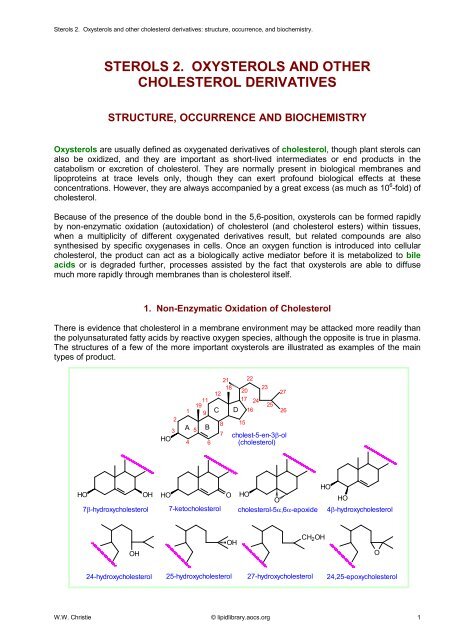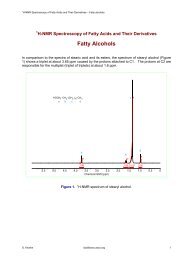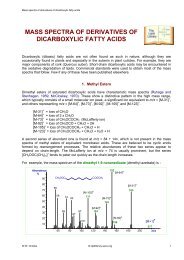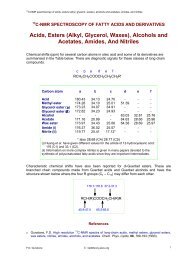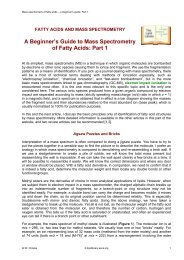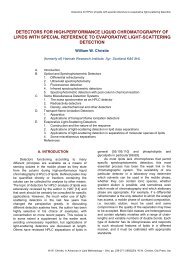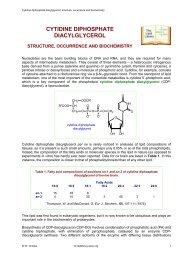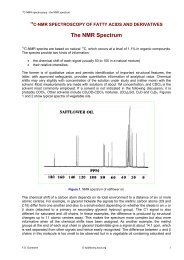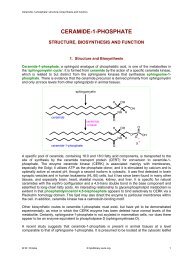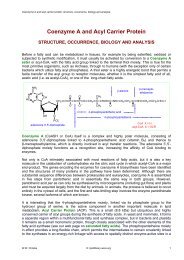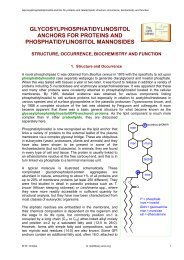sterols 2. oxysterols and other cholesterol derivatives - Lipid Library
sterols 2. oxysterols and other cholesterol derivatives - Lipid Library
sterols 2. oxysterols and other cholesterol derivatives - Lipid Library
You also want an ePaper? Increase the reach of your titles
YUMPU automatically turns print PDFs into web optimized ePapers that Google loves.
Sterols <strong>2.</strong> Oxy<strong>sterols</strong> <strong>and</strong> <strong>other</strong> <strong>cholesterol</strong> <strong>derivatives</strong>: structure, occurrence, <strong>and</strong> biochemistry.<br />
STEROLS <strong>2.</strong> OXYSTEROLS AND OTHER<br />
CHOLESTEROL DERIVATIVES<br />
STRUCTURE, OCCURRENCE AND BIOCHEMISTRY<br />
Oxy<strong>sterols</strong> are usually defined as oxygenated <strong>derivatives</strong> of <strong>cholesterol</strong>, though plant <strong>sterols</strong> can<br />
also be oxidized, <strong>and</strong> they are important as short-lived intermediates or end products in the<br />
catabolism or excretion of <strong>cholesterol</strong>. They are normally present in biological membranes <strong>and</strong><br />
lipoproteins at trace levels only, though they can exert profound biological effects at these<br />
concentrations. However, they are always accompanied by a great excess (as much as 10 6 -fold) of<br />
<strong>cholesterol</strong>.<br />
Because of the presence of the double bond in the 5,6-position, oxy<strong>sterols</strong> can be formed rapidly<br />
by non-enzymatic oxidation (autoxidation) of <strong>cholesterol</strong> (<strong>and</strong> <strong>cholesterol</strong> esters) within tissues,<br />
when a multiplicity of different oxygenated <strong>derivatives</strong> result, but related compounds are also<br />
synthesised by specific oxygenases in cells. Once an oxygen function is introduced into cellular<br />
<strong>cholesterol</strong>, the product can act as a biologically active mediator before it is metabolized to bile<br />
acids or is degraded further, processes assisted by the fact that oxy<strong>sterols</strong> are able to diffuse<br />
much more rapidly through membranes than is <strong>cholesterol</strong> itself.<br />
1. Non-Enzymatic Oxidation of Cholesterol<br />
There is evidence that <strong>cholesterol</strong> in a membrane environment may be attacked more readily than<br />
the polyunsaturated fatty acids by reactive oxygen species, although the opposite is true in plasma.<br />
The structures of a few of the more important oxy<strong>sterols</strong> are illustrated as examples of the main<br />
types of product.<br />
a<br />
2<br />
3<br />
HO<br />
1<br />
A<br />
4<br />
11<br />
19<br />
9<br />
5<br />
B<br />
6<br />
21<br />
18<br />
12<br />
C<br />
8<br />
7<br />
D<br />
cholest-5-en-3β-ol<br />
(<strong>cholesterol</strong>)<br />
HO<br />
HO OH HO O HO<br />
O<br />
HO<br />
7β-hydroxy<strong>cholesterol</strong> 7-keto<strong>cholesterol</strong> <strong>cholesterol</strong>-5α,6α-epoxide 4β-hydroxy<strong>cholesterol</strong><br />
OH<br />
OH<br />
W.W. Christie © lipidlibrary.aocs.org 1<br />
20<br />
17<br />
15<br />
22<br />
16<br />
24<br />
23<br />
25<br />
27<br />
26<br />
CH 2OH<br />
24-hydroxy<strong>cholesterol</strong> 25-hydroxy<strong>cholesterol</strong> 27-hydroxy<strong>cholesterol</strong> 24,25-epoxy<strong>cholesterol</strong><br />
a<br />
O
Sterols <strong>2.</strong> Oxy<strong>sterols</strong> <strong>and</strong> <strong>other</strong> <strong>cholesterol</strong> <strong>derivatives</strong>: structure, occurrence, <strong>and</strong> biochemistry.<br />
Oxy<strong>sterols</strong> can vary in the type (hydroperoxy, hydroxy, keto, epoxy), number <strong>and</strong> position of the<br />
oxygenated functions introduced <strong>and</strong> in the nature of their stereochemistry. Derivatives with the A<br />
<strong>and</strong> B rings <strong>and</strong> the iso-octyl side-chain oxidized are illustrated, but compounds with oxygen<br />
groups in position 15 (D ring) are also important biologically. Usually, they are named in relation to<br />
<strong>cholesterol</strong>, rather than by the strict systematic terminology.<br />
Oxy<strong>sterols</strong> occur in tissues both in the free state <strong>and</strong> esterified with long-chain fatty acids. For<br />
example, in human atherosclerotic lesions, 80-95% of all oxy<strong>sterols</strong> are esterified. Appreciable<br />
amounts of oxy<strong>sterols</strong> can be present in foods, especially those rich in such as meat, eggs <strong>and</strong><br />
dairy products, which are most probably generated non-enzymically during cooking or processing.<br />
They can be absorbed from the intestines <strong>and</strong> transported into the circulation in chylomicrons, but<br />
the extent to which dietary sources contribute to tissue levels either of total oxy<strong>sterols</strong> or of<br />
individual isomers is not known.<br />
Mechanisms of autoxidation have been studied intensively in terms of unsaturated fatty acids, <strong>and</strong><br />
it appears that similar mechanisms operate with <strong>sterols</strong>. The first event in lipid peroxidation is an<br />
initiation reaction in which a carbon with a labile hydrogen undergoes hydrogen abstraction by<br />
reaction with a free radical, which can be a non-lipid species such as a transition metal or<br />
hydroxyl or peroxynitrile radicals, <strong>and</strong> this is followed by oxygen capture. The resulting reactive<br />
species recruits further non-oxidized lipids <strong>and</strong> starts a chain reaction termed the propagation<br />
phase. Finally, the reaction is terminated by the conversion of hydroperoxy intermediates to more<br />
stable hydroxy products by reaction with endogenous antioxidants such as tocopherols.<br />
As an example, the reaction mechanism leading to the production of 7-oxygenated <strong>cholesterol</strong><br />
<strong>derivatives</strong> is illustrated. In aqueous dispersions, oxidation is initiated by a radical attack forming a<br />
delocalized three-carbon allylic radical, which reacts with oxygen to produce the epimeric products<br />
7α- <strong>and</strong> 7β-hydroperoxy-<strong>cholesterol</strong>. Subsequent enzymic <strong>and</strong> non-enzymic reactions lead to the<br />
hydroxy <strong>and</strong> keto analogues, which may be accompanied by epoxy-ene <strong>and</strong> ketodienoic<br />
secondary products.<br />
a<br />
HO<br />
<strong>cholesterol</strong><br />
7<br />
O2<br />
HO<br />
.<br />
HO<br />
H OO.<br />
Reaction does not occur at the <strong>other</strong> allylic carbon 4, presumably because of steric hindrance.<br />
When <strong>cholesterol</strong> is in the solid state, reaction occurs primarily at the tertiary carbon-25, though<br />
some products oxygenated at C-20 may also be produced.<br />
Epimeric 5,6-epoxy-chole<strong>sterols</strong> may be formed by a non-radical reaction involving the nonenzymatic<br />
interaction of a hydroperoxide with the double bond, a process that is believed to occur<br />
in macrophages especially <strong>and</strong> in low-density lipoproteins (LDL). In this instance, the initial<br />
peroxidation product is a polyunsaturated fatty acid; the hydroperoxide transfers an oxygen atom to<br />
<strong>cholesterol</strong> to produce the epoxide, <strong>and</strong> in so doing is reduced to a hydroxyl. Other non-radical<br />
oxidation processes include reaction with singlet oxygen, which is especially important in the<br />
presence of light <strong>and</strong> photosensitizers <strong>and</strong> can generate 5-hydroxy- as well as 6- <strong>and</strong> 7-hydroxy<br />
products. Cholesterol-5,6-epoxides, formed in this way, are presently of interest in relation to<br />
cancer. In addition, reaction with ozone in the lung can generate a family of distinctive oxygenated<br />
<strong>cholesterol</strong> metabolites.<br />
W.W. Christie © lipidlibrary.aocs.org 2<br />
+ RH<br />
HO<br />
H OOH<br />
7α/β-hydroperoxy<strong>cholesterol</strong><br />
a
Sterols <strong>2.</strong> Oxy<strong>sterols</strong> <strong>and</strong> <strong>other</strong> <strong>cholesterol</strong> <strong>derivatives</strong>: structure, occurrence, <strong>and</strong> biochemistry.<br />
Photoxidation in the retina via the action of free radicals or singlet oxygen generates unstable<br />
<strong>cholesterol</strong> hydroperoxides, which may be involved in age-related macular degeneration. For<br />
example, these compounds can quickly be converted to highly toxic 7α- <strong>and</strong> 7βhydroxychole<strong>sterols</strong><br />
<strong>and</strong> 7-keto<strong>cholesterol</strong>, depending on the status of tissue oxidases <strong>and</strong><br />
reductases. Three separate enzymatic pathways have developed in the eye to neutralize their<br />
activity. 7-Keto<strong>cholesterol</strong> is a major oxysterol produced during oxidation of low-density<br />
lipoproteins, <strong>and</strong> is one of the most abundant in plasma <strong>and</strong> atherosclerotic lesions, with a high<br />
pro-apoptotic potential. It associates preferentially with membrane lipid raft domains.<br />
<strong>2.</strong> Enzymatic Oxidation of Cholesterol<br />
Within animal cells, oxidation of <strong>sterols</strong> is mainly an enzymic process that is carried out by several<br />
enzymes that are mainly from the cytochrome P450 family of oxygenases (they have a<br />
characteristic absorption at 450 nm). These are a disparate group of proteins that contain a single<br />
heme group <strong>and</strong> have a similar structural fold, though the amino acid sequences can differ<br />
appreciably. They are all mono-oxygenases. As some of them are specific to particular tissues,<br />
there is considerable variation in oxysterol distributions between organs. For example, a primary<br />
product is 7α-hydroxy<strong>cholesterol</strong>, which is an important intermediate in the biosynthesis of bile<br />
acids (see below) <strong>and</strong> it is produced in the liver by the action of <strong>cholesterol</strong> 7α-hydroxylase<br />
(CYP7A1), which has a critical role in <strong>cholesterol</strong> homoeostasis. The reaction is under strict<br />
regulatory control, <strong>and</strong> any circulating 7α-hydroxy<strong>cholesterol</strong> represents leakage from the liver. On<br />
the <strong>other</strong> h<strong>and</strong>, 7β-hydroxy<strong>cholesterol</strong> is produced in brain by the action of the toxic β-amyloid<br />
peptide <strong>and</strong> its precursor on <strong>cholesterol</strong>. Whether this metabolite is involved in the pathology of<br />
Alzheimer’s disease has yet to be determined.<br />
An alternative pathway to bile acids starts with 27-hydroxy<strong>cholesterol</strong>, which is produced by<br />
an<strong>other</strong> cytochrome P450 enzyme (CYP27A1), which introduces the hydroxyl group into the<br />
terminal methyl carbon (C-27). While this enzyme is present in the liver, it is found in many extrahepatic<br />
tissues <strong>and</strong> especially the lung, which provides a steady flux of 27-oxygenated metabolites<br />
to the liver. It is involved in some of the later stages of bile acid production (see below). In addition,<br />
as a multifunctional mitochondrial P450 enzyme in liver, it generates both 25R,26hydroxy<strong>cholesterol</strong><br />
<strong>and</strong> 3β-hydroxy-5-cholestenoic acid, which occur in small but significant<br />
amounts in plasma.<br />
In humans, the specific cytochrome P450 that produces 24S-hydroxy<strong>cholesterol</strong> (cholest-5-ene-<br />
3β,24-diol), <strong>cholesterol</strong> 24S-hydroxylase (CYP46A1), is located almost entirely in the smooth<br />
endoplasmic reticulum of neurons in the brain, <strong>and</strong> even the 24S-hydroxy<strong>cholesterol</strong> found in<br />
plasma is derived from the brain. The enzyme is expressed in neurons, including those of the<br />
hippocampus <strong>and</strong> cortex, which are important for learning <strong>and</strong> memory, <strong>and</strong> it is responsible for<br />
most of the turnover of <strong>cholesterol</strong> in the central nervous system.<br />
25-Hydroxy<strong>cholesterol</strong> is quantitatively a relatively minor but biologically important <strong>cholesterol</strong><br />
metabolite. At least two cytochrome P450 enzymes, CYP27A1 <strong>and</strong> CYP3A4, catalyse the<br />
conversion of <strong>cholesterol</strong> in vitro, as does the dioxygenase enzyme <strong>cholesterol</strong> 25-hydroxylase.<br />
However, the relative importance of the different mechanisms of formation in vivo have still to be<br />
elucidated. Cholesterol autoxidation does not seem to be an important contributor.<br />
24(S),25-Epoxy<strong>cholesterol</strong> is not produced by the pathways described above but is synthesised<br />
in a shunt of the same mevalonate pathway that produces <strong>cholesterol</strong>. It may represent a measure<br />
of newly synthesised <strong>cholesterol</strong>.<br />
W.W. Christie © lipidlibrary.aocs.org 3
Sterols <strong>2.</strong> Oxy<strong>sterols</strong> <strong>and</strong> <strong>other</strong> <strong>cholesterol</strong> <strong>derivatives</strong>: structure, occurrence, <strong>and</strong> biochemistry.<br />
The important human pathogen, Mycobacterium tuberculosis, utilizes a cytochrome P450 enzyme<br />
(CYP125) to catalyse C26/C27 hydroxylation of <strong>cholesterol</strong> as an essential early step in its<br />
catabolism as part of the infective process.<br />
The oxy<strong>sterols</strong> formed by both autoxidation <strong>and</strong> enzymatic routes can undergo further oxidationreduction<br />
reactions, <strong>and</strong> they can be modified by many of the enzymes involved in the metabolism<br />
of <strong>cholesterol</strong> <strong>and</strong> steroidal hormones, such as esterification <strong>and</strong> sulfation, as illustrated for 7-keto<strong>cholesterol</strong>.<br />
a<br />
O<br />
R O O<br />
7-keto-<strong>cholesterol</strong> ester<br />
(LCAT/ACAT)<br />
esterification<br />
oxidation<br />
(CPY27)<br />
HO O<br />
reduction<br />
sulfation 7-keto-<strong>cholesterol</strong> (CYP11)<br />
_<br />
O3S<br />
O O<br />
HO OH<br />
7-keto-<strong>cholesterol</strong> 3-sulfate 7β-hydroxy-<strong>cholesterol</strong><br />
Catabolism. Because of their increased polarity relative to <strong>cholesterol</strong>, oxy<strong>sterols</strong> can exit cells<br />
relatively easily. Some are converted to inert sterol esters <strong>and</strong> stored in this form, a proportion is<br />
further oxidized <strong>and</strong> converted to bile acids, <strong>and</strong> some are converted to sulfate esters (especially<br />
at the 3-hydroxyl group) or glucuronides (see below) for elimination.<br />
3. Oxy<strong>sterols</strong> – Biological Activity<br />
CH 2OH<br />
27-hydroxy-7-keto-<strong>cholesterol</strong><br />
In tissues in vivo, the very low oxysterol:<strong>cholesterol</strong> ratio means that oxy<strong>sterols</strong> have little impact<br />
on the primary role of <strong>cholesterol</strong> in cell membrane structure <strong>and</strong> function. Indeed, it is often<br />
argued that there are few reliable measurements of cellular or subcellular oxysterol concentrations,<br />
because of the technical difficulties in the analysis of the very low concentrations of oxy<strong>sterols</strong> in<br />
the presence of a vast excess of native <strong>cholesterol</strong>. Nonetheless, aside from their role as<br />
precursors of bile acids <strong>and</strong> some steroidal hormones, it is evident that oxy<strong>sterols</strong> have a variety of<br />
roles in terms of maintaining <strong>cholesterol</strong> homeostasis <strong>and</strong> perhaps in signalling. Autoxidation<br />
products of <strong>cholesterol</strong> may be useful markers for oxidative stress.<br />
While <strong>cholesterol</strong> plays a key role in its own feedback regulation, there is some evidence that<br />
oxy<strong>sterols</strong> are also inhibitors of <strong>cholesterol</strong> biosynthesis, <strong>and</strong> 25-hydroxy<strong>cholesterol</strong> <strong>and</strong><br />
24(S),25-epoxy<strong>cholesterol</strong> may be especially effective, although the <strong>other</strong> side-chain oxy<strong>sterols</strong><br />
24- <strong>and</strong> 27-hydroxy<strong>cholesterol</strong> are also implicated. Several mechanisms appear to be involved,<br />
<strong>and</strong> it is suggested that they inhibit the transcription of key genes in <strong>cholesterol</strong> biosynthesis<br />
(‘sterol regulatory element binding protein’ (SREBP) transcription factors), as well as directly<br />
W.W. Christie © lipidlibrary.aocs.org 4<br />
a
Sterols <strong>2.</strong> Oxy<strong>sterols</strong> <strong>and</strong> <strong>other</strong> <strong>cholesterol</strong> <strong>derivatives</strong>: structure, occurrence, <strong>and</strong> biochemistry.<br />
inhibiting or accelerating the degradation of such important enzymes in the process as HMG-CoA<br />
reductase <strong>and</strong> squalene synthase. Oxy<strong>sterols</strong> could smooth out the regulation of <strong>cholesterol</strong><br />
metabolism, preventing exaggerated responses. However, some experts in the field caution that it<br />
can be difficult to extrapolate from experiments in vitro to the situation in vivo, because of the<br />
rapidity with which <strong>cholesterol</strong> can autoxidize in experimental systems <strong>and</strong> because of the difficulty<br />
of carrying out experiments with physiological levels of oxy<strong>sterols</strong>. Claims that oxy<strong>sterols</strong> are<br />
master regulators of <strong>cholesterol</strong> homeostasis in vivo are now disputed.<br />
25-Hydroxy<strong>cholesterol</strong> is also reported to have a regulatory effect on the biosynthesis of<br />
sphingomyelin, which is required with <strong>cholesterol</strong> for the formation of raft sub-domains in<br />
membranes, <strong>and</strong> together with <strong>other</strong> oxy<strong>sterols</strong> to regulate the activities of some hedgehog<br />
proteins involved in embryonic development. A metabolite 7α,25-dihydroxy<strong>cholesterol</strong> functions<br />
may have a role in theregulation of humoral immunity.<br />
Oxy<strong>sterols</strong> are especially important for <strong>cholesterol</strong> homeostasis in the brain, which contains 25% of<br />
the total body <strong>cholesterol</strong>, virtually all of it in unesterified form, in only about 2% of the body<br />
volume. Cholesterol is a major component of the plasma membrane especially, where it serves to<br />
control the fluidity <strong>and</strong> permeability. This membrane is produced in large amounts in brain <strong>and</strong> is<br />
the basis of the compacted myelin, which is essential for conductance of electrical stimuli <strong>and</strong><br />
contains about 70% of the <strong>cholesterol</strong> in brain. This pool is relatively stable, but the remaining 30%<br />
is present in the membranes of neurons <strong>and</strong> glial cells of gray matter <strong>and</strong> is active metabolically.<br />
Even in the foetus <strong>and</strong> the newborn infant, all the <strong>cholesterol</strong> required for growth is produced by<br />
synthesis de novo in the brain not by transfer from the circulation across the blood-brain barrier,<br />
which consists of tightly opposed endothelial cells lining the extensive vasculature of the tissue.<br />
The fact that this pool of <strong>cholesterol</strong> in the brain is independent of circulating levels must reflect a<br />
requirement for constancy in the content of this lipid in membranes <strong>and</strong> myelin. In adults, although<br />
there is a continuous turnover of membrane, the <strong>cholesterol</strong> is efficiently re-cycled <strong>and</strong> has a<br />
remarkably high half-life (up to 5 years). The rate of <strong>cholesterol</strong> synthesis is a little greater than the<br />
actual requirement, so that net movement of <strong>cholesterol</strong> out of the central nervous system must<br />
occur.<br />
If <strong>cholesterol</strong> itself cannot cross the blood-brain barrier, its metabolite 24(S)-hydroxy<strong>cholesterol</strong> is<br />
able to do so with relative ease. When the hydroxyl group is introduced into the side chain, this<br />
oxysterol effects a local re-ordering of<br />
membrane phospholipids such that it is more<br />
favourable energetically to expel it, <strong>and</strong> this<br />
can occur at a rate that is orders of magnitude<br />
greater than that of <strong>cholesterol</strong> per se, though<br />
still only 6-7 mg per day. There is a continuous<br />
flow of this metabolite from the brain into the<br />
circulation, where it is transported by<br />
lipoprotein particles to the liver for further<br />
catabolism, i.e. it is hydroxylated in position 7<br />
<strong>and</strong> then converted to bile acids.<br />
Both 24(S)-hydroxy<strong>cholesterol</strong> <strong>and</strong> 24(S),25epoxy<strong>cholesterol</strong><br />
are believed to be important<br />
in regulating <strong>cholesterol</strong> homeostasis in the<br />
brain. They interact with the specific nuclear<br />
receptors involved in the expression <strong>and</strong><br />
synthesis of proteins involved in sterol<br />
transport.<br />
27-Hydroxy<strong>cholesterol</strong> diffuses across the<br />
blood-brain barrier in the reverse direction from<br />
27-carboxy<br />
steroids<br />
W.W. Christie © lipidlibrary.aocs.org 5<br />
27-OH<br />
brain<br />
Liver<br />
extrahepatic<br />
cells
Sterols <strong>2.</strong> Oxy<strong>sterols</strong> <strong>and</strong> <strong>other</strong> <strong>cholesterol</strong> <strong>derivatives</strong>: structure, occurrence, <strong>and</strong> biochemistry.<br />
the blood stream into the brain, where it does not accumulate but is further oxidized <strong>and</strong> then<br />
exported as steroidal acids. This flux may regulate certain key enzymes within the brain, <strong>and</strong> there<br />
are suggestions that the balance between the levels of 24- <strong>and</strong> 27-hydroxy-<strong>cholesterol</strong> may be<br />
relevant to the generation of β-amyloid peptides. 27-Hydroxy<strong>cholesterol</strong> is also an element in<br />
<strong>cholesterol</strong> elimination from macrophages <strong>and</strong> arterial endothelial cells.<br />
Especially high levels of 24(S)-hydroxy<strong>cholesterol</strong> are observed in the plasma of human infants<br />
<strong>and</strong> in patients with brain trauma, while reduced levels are found in patients with<br />
neurodegenerative diseases, including multiple sclerosis <strong>and</strong> Alzheimer’s disease (it may be<br />
protective against β-amyloid peptide, the amyloidogenic peptide found in brain in this condition). In<br />
contrast, 7β-hydroxy<strong>cholesterol</strong>, produced by this protein, is pro-apoptotic, but any links with the<br />
disease are unproven.<br />
Oxy<strong>sterols</strong> appear to be important for many aspects of <strong>cholesterol</strong> turnover <strong>and</strong> transport, <strong>and</strong><br />
there have been many reports of involvement in disease processes, especially atherosclerosis <strong>and</strong><br />
the formation of human atherosclerotic plaques, but also cytotoxicity, necrosis, inflammation,<br />
immuno-suppression, phospholipidosis <strong>and</strong> gallstone formation. Those oxy<strong>sterols</strong> formed nonenzymatically<br />
are most troublesome in this regard. For example, they are enriched in pathologic<br />
cells <strong>and</strong> tissues, such as macrophage foam cells, atherosclerotic lesions, <strong>and</strong> cataracts. They<br />
may regulate some of the metabolic effects of <strong>cholesterol</strong>, but as cautioned above, effects<br />
observed in vitro may not necessarily be of physiological importance in vivo. Similarly, it has been<br />
argued that plasma oxy<strong>sterols</strong> could serve as markers of oxidative stress, but the experimental<br />
difficulties in analysis have been such that their value has been limited. Sample h<strong>and</strong>ling remains a<br />
problem, but the newer methods of mass spectrometry with electrospray ionization now enable<br />
direct analysis of even the reactive hydroxy-, hydroperoxy- <strong>and</strong> ozonide-containing oxy<strong>sterols</strong>.<br />
4. Cholesterol 3-sulfate<br />
The strongly acidic sulfate ester of <strong>cholesterol</strong> occurs in all mammalian cells, but it is especially<br />
abundant in keratinized tissue, such as skin <strong>and</strong> hooves. Although present at low levels, it can be<br />
the main sulfolipid in many cell types, but especially kidney, <strong>and</strong> reproductive <strong>and</strong> nervous tissues.<br />
In many organs, it appears to be concentrated in epithelial cell walls or in plasma membranes.<br />
Cholesterol sulfate is the main circulating sterol sulfate in plasma, although it is there accompanied<br />
by dehydroepi<strong>and</strong>rosterone sulfate, the function of which is unknown. In addition, 7-keto<strong>cholesterol</strong><br />
sulfate has been found in primate retina, while 24-hydroxy<strong>cholesterol</strong> occurs in bovine brain as its<br />
sulfate ester.<br />
+<br />
X<br />
_<br />
O3SO<br />
<strong>cholesterol</strong><br />
sulfate<br />
Cholesterol sulfate may have a role in ensuring the integrity <strong>and</strong> adhesion of the various skin<br />
layers, while also regulating some enzyme activities. For example, it functions in keratinocyte<br />
differentiation, inducing genes that encode for key components involved in development of the<br />
barrier. However, the function of this lipid is still only partly understood. It may play a part in cell<br />
adhesion, differentiation <strong>and</strong> signal transduction. In addition, it has a stabilizing role, for example in<br />
protecting erythrocytes from osmotic lysis <strong>and</strong> regulating sperm capacitation.<br />
W.W. Christie © lipidlibrary.aocs.org 6
Sterols <strong>2.</strong> Oxy<strong>sterols</strong> <strong>and</strong> <strong>other</strong> <strong>cholesterol</strong> <strong>derivatives</strong>: structure, occurrence, <strong>and</strong> biochemistry.<br />
Sterol sulfates have been detected occasionally in lower life forms, such as the sea star, Asterius<br />
rubrius, <strong>and</strong> the marine diatom, Nitzschia alba.<br />
5. Cholesterol Glycosides <strong>and</strong> Other Cholesterol Derivatives<br />
Cholesterol is found linked covalently to specific proteins where it functions to anchor the protein in<br />
a membrane, but this is discussed in our web page on proteolipids. Cholesteryl glucoside <strong>and</strong><br />
acyl cholesteryl glucoside have been found in the skin of snakes <strong>and</strong> birds. Cholesteryl glucoside<br />
occurs also in human fibroblasts, <strong>and</strong> some rat tissues, where it may act as a mediator of signal<br />
transduction in the early stages of stress. As with plant <strong>and</strong> fungal steryl glycosides, these have a<br />
sugar β-glucosidic linkage. In addition, a <strong>cholesterol</strong>-conjugate with glucuronic acid has been<br />
isolated from human liver (33 nmol/g wet tissue) <strong>and</strong> plasma, but its origin, function <strong>and</strong> metabolic<br />
fate are unknown.<br />
Some bacterial species contain <strong>cholesterol</strong> glycosides, <strong>and</strong> four unusual glycolipids, i.e.<br />
cholesteryl-α-glucoside, cholesteryl-6'-O-acyl-α-glucoside, cholesteryl-6'-O-phosphatidyl-αglucoside,<br />
<strong>and</strong> cholesteryl-6'-O-lysophosphatidyl-α-glucoside, occur in the pathogenic bacterium<br />
Helicobacter pylori, for example. The key enzyme involved in their biosynthesis is a membranebound,<br />
UDP-glucose-dependent <strong>cholesterol</strong>-α–glucosyltransferase. These lipids appear to support<br />
the pathogenicity of the organism. Cholesterol 6-O-acyl-β-D-galactopyranoside <strong>and</strong> its nonacylated<br />
form are significant components of membranes of the spirochete Borrelia burgdorferi,<br />
which is the causative agent of Lyme disease. Sterol glycosides are more common constituents of<br />
plants (see our web page on plant <strong>sterols</strong>).<br />
6. Vitamin D<br />
Vitamin D encompasses two main sterol metabolites that are<br />
essential for the regulation of calcium <strong>and</strong> phosphorus levels<br />
<strong>and</strong> thence for bone formation in animals. However, these<br />
have many <strong>other</strong> functions, including induction of cell<br />
differentiation, inhibition of cell growth, immunomodulation,<br />
<strong>and</strong> control of <strong>other</strong> hormonal systems. In addition to the well<br />
known responsibility for rickets, Vitamin D deficiency is<br />
associated with various cancers <strong>and</strong> autoimmune diseases.<br />
Ultraviolet light mediates cleavage of 7-dehydro<strong>cholesterol</strong><br />
with opening of the second (B) ring in the skin to produce<br />
pre-vitamin D, which rearranges spontaneously to form the<br />
secosteroid vitamin D3 or cholecalciferol. The newly<br />
generated vitamin D3 is transported to the liver where it is<br />
subject to 25-hydroxylation <strong>and</strong> thence to the kidney for 1αhydroxylation<br />
to form 1α,25-dihydroxyvitamin D3 (calcitriol), a<br />
high affinity lig<strong>and</strong> for the vitamin D receptor. Vitamin D2 or<br />
ergocalciferol is derived from ergosterol <strong>and</strong> is obtained from<br />
plant <strong>and</strong> fungal sources in the diet.<br />
cholecalciferol<br />
vitamin D3 Vitamin D3 functions by activating a cellular receptor (vitamin D receptor or VDR), which alters the<br />
transcription rates of the specific genes responsible for the biological responses.<br />
W.W. Christie © lipidlibrary.aocs.org 7<br />
a<br />
HO<br />
H<br />
a
Sterols <strong>2.</strong> Oxy<strong>sterols</strong> <strong>and</strong> <strong>other</strong> <strong>cholesterol</strong> <strong>derivatives</strong>: structure, occurrence, <strong>and</strong> biochemistry.<br />
7. Steroidal Hormones <strong>and</strong> their Esters<br />
These lipids cannot be discussed in depth here. In brief, in addition to the bulk <strong>sterols</strong>, animal<br />
tissues produce small amounts of vital steroidal hormones, including oestrogens <strong>and</strong> progesterone,<br />
which are made primarily in the ovary <strong>and</strong> placenta during pregnancy, <strong>and</strong> testosterone mainly in<br />
the testes (the structure of pregnenolone is illustrated below as an example). Pregnane<br />
neurosteroids are produced in the central nervous system. Conversion of <strong>cholesterol</strong> to<br />
pregnenolone in mitochondria is the rate-limiting step <strong>and</strong> involves first hydroxylation <strong>and</strong> then<br />
cleavage of the side-chain.<br />
a<br />
pregnenolone<br />
HO<br />
H<br />
H<br />
H<br />
Steroidal esters accumulate in tissues such as the adrenal gl<strong>and</strong>s, which synthesise<br />
corticosteroids such as cortisol <strong>and</strong> aldosterone <strong>and</strong> are responsible for releasing hormones in<br />
response to stress <strong>and</strong> <strong>other</strong> factors. It is also apparent that fatty acyl esters of estradiols, such as<br />
dehydroepi<strong>and</strong>rosterone, accumulate in adipose tissue in postmenopausal women. Small amounts<br />
estrogens, acylated with fatty acids at C-17 hydroxyl, are also found in the plasma lipoproteins. In<br />
each instance they appear to be biologically inert storage or transport forms of the steroid.<br />
Eventually, esterified steroids in low density lipoproteins (LDL) particles are taken up by cells via<br />
lipoprotein receptors, <strong>and</strong> they hydrolysed to release the active steroid.<br />
There is currently great pharmaceutical interest in oleoyl-estrone, a naturally occurring hormone in<br />
humans, which was found to induce a marked loss of body-fat while preserving protein stores in<br />
animals, a desirable goal for anti-obesity drug as body protein loss is an unwanted side effect of fat<br />
loss via calorie restriction.<br />
Recommended Reading<br />
o Björkhem, I. Five decades with oxy<strong>sterols</strong>. Biochimie, 95, 448-454 (2013).<br />
O<br />
o Brown, A.J. Cholesterol versus <strong>other</strong> <strong>sterols</strong>: How do they compare as physiological regulators of<br />
<strong>cholesterol</strong> homeostasis? Eur. J. <strong>Lipid</strong> Sci. Technol., 114, 617–623 (2012).<br />
o Diczfalusy, U. On the formation <strong>and</strong> possible biological role of 25-hydroxy<strong>cholesterol</strong>. Biochimie, 95,<br />
455-460 (2013).<br />
o Dietschy, J.M. <strong>and</strong> Turley, S.D. Brain <strong>Lipid</strong>s. Cholesterol metabolism in the central nervous system<br />
during early development <strong>and</strong> in the mature animal. J. <strong>Lipid</strong> Res., 45, 1375-1397 (2004).<br />
o Dusso, A.D., Brown, A.J. <strong>and</strong> Slatopolsky, E. Vitamin D. Am. J. Physiol. Renal. Physiol., 289, F8–28<br />
(2005).<br />
o Gill, S., Chow, R. <strong>and</strong> Brown, A.J. Sterol regulators of <strong>cholesterol</strong> homeostasis <strong>and</strong> beyond: The<br />
oxysterol hypothesis revisited <strong>and</strong> revised. Prog. <strong>Lipid</strong> Res., 47, 391-404 (2008).<br />
o Griffiths, W.J. <strong>and</strong> Wang, Y. Sterol lipidomics in health <strong>and</strong> disease: Methodologies <strong>and</strong> applications.<br />
Eur. J. <strong>Lipid</strong> Sci. Technol., 111, 14-38 (2009).<br />
o Iuliano, L. Pathways of <strong>cholesterol</strong> oxidation via non-enzymatic mechanisms. Chem. Phys. <strong>Lipid</strong>s, 164,<br />
457-468 (2011).<br />
o Leoni, V. <strong>and</strong> Caccia, C. 24S-Hydroxy<strong>cholesterol</strong> in plasma: A marker of <strong>cholesterol</strong> turnover in<br />
neurodegenerative diseases. Biochimie, 95, 595-612 (2013).<br />
W.W. Christie © lipidlibrary.aocs.org 8<br />
O<br />
oleoyl-estrone<br />
O<br />
H<br />
H<br />
H<br />
O<br />
a
Sterols <strong>2.</strong> Oxy<strong>sterols</strong> <strong>and</strong> <strong>other</strong> <strong>cholesterol</strong> <strong>derivatives</strong>: structure, occurrence, <strong>and</strong> biochemistry.<br />
o Lordan, S., Mackrill, J.J. <strong>and</strong> O'Brien, N.M. Oxy<strong>sterols</strong> <strong>and</strong> mechanisms of apoptotic signaling:<br />
implications in the pathology of degenerative diseases. J. Nutr. Biochem., 20, 321-336 (2009).<br />
o McLean, K.J., Hans, M. <strong>and</strong> Munro, A.W. Cholesterol, an essential molecule: diverse roles involving<br />
cytochrome P450 enzymes. Biochem. Soc. Trans., 40, 587-593 (2012).<br />
o Murphy, R.C. <strong>and</strong> Johnson, K.M. Cholesterol, reactive oxygen species, <strong>and</strong> the formation of biologically<br />
active mediators. J. Biol. Chem., 283, 15521-15525 (2008).<br />
o Strott, C.A. <strong>and</strong> Higashi, Y. Cholesterol sulfate in human physiology: what's it all about? J. <strong>Lipid</strong> Res.,<br />
44, 1268-1278 (2003).<br />
o Vihma, V. <strong>and</strong> Tikkanen, M.J. Fatty acid esters of steroids: Synthesis <strong>and</strong> metabolism in lipoproteins<br />
<strong>and</strong> adipose tissue. J. Steroid Biochem. Mol. Biol., 124, 65-76 (2011).<br />
William W. Christie<br />
James Hutton Institute (<strong>and</strong> Mylnefield <strong>Lipid</strong> Analysis), Invergowrie, Dundee (DD2<br />
5DA), Scotl<strong>and</strong><br />
Last updated: April 22 nd , 2013<br />
W.W. Christie © lipidlibrary.aocs.org 9


